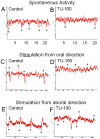The effects of daikenchuto (DKT) on propulsive motility in the colon
- PMID: 19631346
- PMCID: PMC2945404
- DOI: 10.1016/j.jss.2009.03.068
The effects of daikenchuto (DKT) on propulsive motility in the colon
Abstract
Background: The purpose of this study is to examine the use of daikenchuto (DKT), a traditional Japanese medicine, as a potential treatment for opiate-induced slowing of intestinal transit in an isolated guinea pig colon model of motility.
Methods: Isolated segments of distal guinea pig colon were mounted in a perfusion chamber and imaged with a digital video camera interfaced with a computer. Fecal pellets were inserted into the oral end of the colonic segment and the rates of propulsive motility over a 3 to 4 cm segment of colon were determined in the presence and absence of test compounds. In addition, intracellular recordings were obtained from intact circular muscle, and the responsiveness of inhibitory and excitatory junction potentials to DKT was evaluated.
Results: The addition of D-Ala2, N-Me-Phe4, Gly-ol5 (DAMGO), a selective μ-receptor agonist, caused a concentration dependent decrease in colon motility. Naloxone did not affect basal activity, but partially restored motility in the DAMGO treated preparations. DKT (1 × 10(-4)-3 × 10(-4)g/mL) also reversed the inhibitory effect of DAMGO treated colon in a concentration dependent manner. At higher concentrations (1 × 10(-3)-3 × 10(-3)g/mL), however, this effect was lost. Motility slowed even further when naloxone and DKT were combined with noticeable disruptions in spatiotemporal patterns. Interestingly, when added alone, DKT resulted in reverse peristalsis of the pellet. In electrophysiologic studies DKT inhibited both excitatory and inhibitory junction potentials.
Conclusions: DKT appears to be as effective as naloxone in restoring motility in DAMGO treated colon. These two agents, however, do not appear to have an additive effect. When used on untreated colon segments, DKT appears to cause disruptions in the intrinsic reflex circuit of the gut resulting in a disruption of neuromuscular communication.
Copyright © 2010 Elsevier Inc. All rights reserved.
Figures







Similar articles
-
Daikenchuto, a traditional Japanese herbal medicine, promotes colonic transit by inducing a propulsive movement pattern.Neurogastroenterol Motil. 2019 Nov;31(11):e13689. doi: 10.1111/nmo.13689. Epub 2019 Aug 2. Neurogastroenterol Motil. 2019. PMID: 31374154 Free PMC article.
-
The traditional antidiarrheal remedy, Garcinia buchananii stem bark extract, inhibits propulsive motility and fast synaptic potentials in the guinea pig distal colon.Neurogastroenterol Motil. 2010 Dec;22(12):1332-9. doi: 10.1111/j.1365-2982.2010.01583.x. Epub 2010 Aug 16. Neurogastroenterol Motil. 2010. PMID: 20718943 Free PMC article.
-
Role of kappa opioid receptors in modulating cholinergic twitches in the circular muscle of guinea-pig colon.Br J Pharmacol. 1996 Nov;119(5):985-9. doi: 10.1111/j.1476-5381.1996.tb15768.x. Br J Pharmacol. 1996. PMID: 8922749 Free PMC article.
-
Dual effect of trimebutine on contractility of the guinea pig ileum via the opioid receptors.Gastroenterology. 1991 Dec;101(6):1579-87. doi: 10.1016/0016-5085(91)90395-2. Gastroenterology. 1991. PMID: 1659547
-
An enteric occult reflex underlies accommodation and slow transit in the distal large bowel.Gastroenterology. 2007 May;132(5):1912-24. doi: 10.1053/j.gastro.2007.02.047. Epub 2007 Feb 23. Gastroenterology. 2007. PMID: 17484884
Cited by
-
Gastrointestinal Motility Monitor (GIMM).J Vis Exp. 2010 Dec 1;(46):2435. doi: 10.3791/2435. J Vis Exp. 2010. PMID: 21189461 Free PMC article.
-
Spatiotemporal Mapping of Motility in Ex Vivo Preparations of the Intestines.J Vis Exp. 2016 Jan 27;(107):e53263. doi: 10.3791/53263. J Vis Exp. 2016. PMID: 26863156 Free PMC article.
-
Garcinia buchananii stem bark extract and its bioactive constituents manniflavanone, GB-2 and buchananiflavanone attenuate intestinal inhibitory neuromuscular transmission.J Smooth Muscle Res. 2023;59:34-57. doi: 10.1540/jsmr.59.34. J Smooth Muscle Res. 2023. PMID: 37407438 Free PMC article.
-
Kampo medicines for gastrointestinal tract disorders: a review of basic science and clinical evidence and their future application.J Gastroenterol. 2013 Apr;48(4):452-62. doi: 10.1007/s00535-013-0788-z. Epub 2013 Mar 16. J Gastroenterol. 2013. PMID: 23503839 Free PMC article. Review.
-
Analysis of spatiotemporal pattern and quantification of gastrointestinal slow waves caused by anticholinergic drugs.Organogenesis. 2017 Apr 3;13(2):39-62. doi: 10.1080/15476278.2017.1295904. Epub 2017 Feb 23. Organogenesis. 2017. PMID: 28277890 Free PMC article.
References
-
- Wood JD, Galligan JJ. Function of opioids in the enteric nervous system. Neurogastroenterol Motil. 2004 Oct;16(Suppl 2):17–28. - PubMed
-
- Nishiwaki H, Saitoh N, Nishio H, et al. Possible role of potassium channels in mu-receptor mediated inhibition and muscarinic autoinhibition in acetylcholine release from the myenteric plexus of guinea pig ileum. Jpn J Pharmacol. 2000;82:343–349. - PubMed
-
- Frantzides CT, Cowles V, Salaymeh B, et al. Morphine effects on human colonic myoelectric activity in the postoperative period. Am J Surg. 1992;163:144–148. - PubMed
-
- Schmidt WK. Alvimopan (ADL 8-2698) is a novel peripheral opioid antagonist. Am J Surg. 2001;182:27S–38S. - PubMed
-
- Camilleri M. Alvimopan, a selective peripherally acting μ-opioid antagonist. Neurogastroenterol Motil. 2005;7:157–165. - PubMed
Publication types
MeSH terms
Substances
Grants and funding
LinkOut - more resources
Full Text Sources
Other Literature Sources
Research Materials

